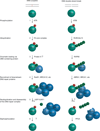Chromatin recruitment of DNA repair proteins: lessons from the fanconi anemia and double-strand break repair pathways
- PMID: 18995829
- PMCID: PMC3753040
- DOI: 10.1016/j.molcel.2008.10.009
Chromatin recruitment of DNA repair proteins: lessons from the fanconi anemia and double-strand break repair pathways
Abstract
In response to DNA damage, eukaryotic cells must rapidly load DNA repair proteins onto damaged chromatin. Chromatin recruitment often entails ubiquitination of a damage-specific DNA repair protein, interaction with a ubiquitin binding factor, assembly of a multisubunit DNA repair complex, and eventually a deubiquitination event once the DNA repair reaction has been completed. This review focuses on the recent discoveries in the Fanconi Anemia (FA) and DNA double-strand break (DSB) repair pathways, which underscore the importance of regulated chromatin loading in the DNA damage response. Interestingly, these two pathways share several features, suggesting a more general mechanism for DNA-repair regulation.
Figures


References
-
- Bienko M, Green CM, Crosetto N, Rudolf F, Zapart G, Coull B, Kannouche P, Wider G, Peter M, Lehmann AR, et al. Ubiquitin-binding domains in Y-family polymerases regulate translesion synthesis. Science. 2005;310:1821–1824. - PubMed
-
- Chowdhury D, Keogh MC, Ishii H, Peterson CL, Buratowski S, Lieberman J. gamma-H2AX dephosphorylation by protein phosphatase 2A facilitates DNA double-strand break repair. Mol Cell. 2005;20:801–809. - PubMed
-
- Ciccia A, Ling C, Coulthard R, Yan Z, Xue Y, Meetei AR, Laghmani el H, Joenje H, McDonald N, de Winter JP, et al. Identification of FAAP24, a Fanconi anemia core complex protein that interacts with FANCM. Mol Cell. 2007;25:331–343. - PubMed
-
- Cohn MA, Kowal P, Yang K, Haas W, Huang TT, Gygi SP, D'Andrea AD. A UAF1-containing multisubunit protein complex regulates the Fanconi anemia pathway. Mol Cell. 2007;28:786–797. - PubMed
Publication types
MeSH terms
Substances
Grants and funding
LinkOut - more resources
Full Text Sources

